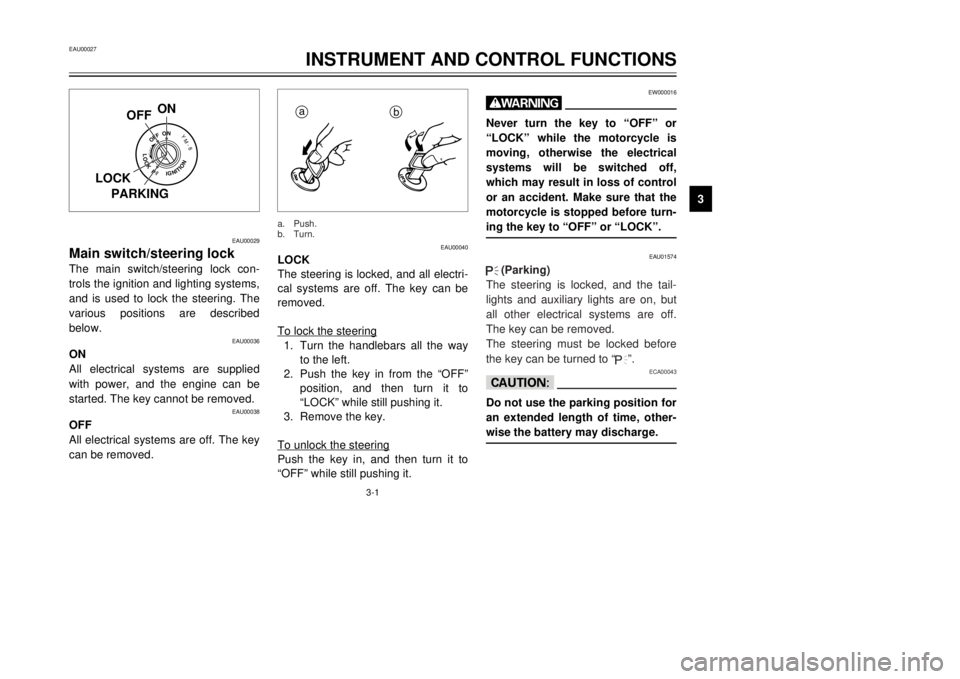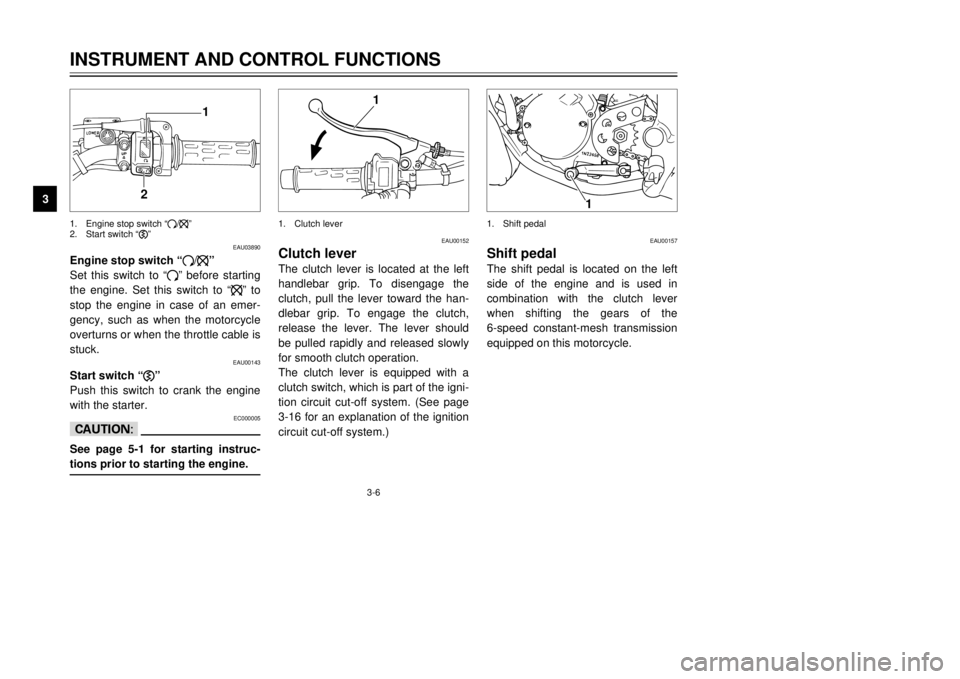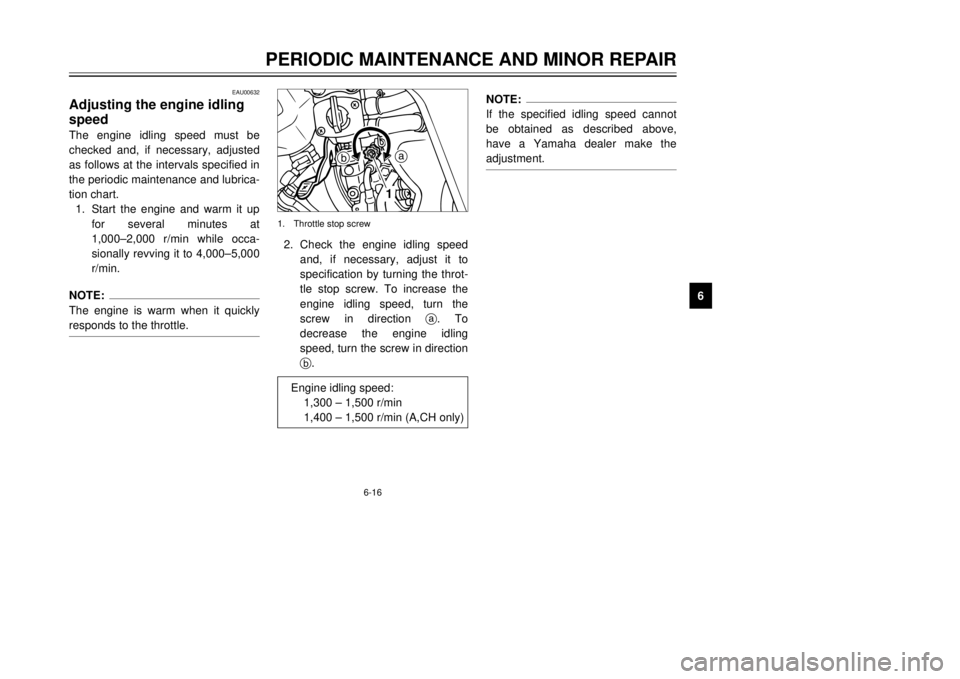2002 YAMAHA TDR 125 stop start
[x] Cancel search: stop startPage 12 of 94

3-1
EAU00027
INSTRUMENT AND CONTROL FUNCTIONS
3
EAU00029
Main switch/steering lockThe main switch/steering lock con-
trols the ignition and lighting systems,
and is used to lock the steering. The
various positions are described
below.
EAU00036
ON
All electrical systems are supplied
with power, and the engine can be
started. The key cannot be removed.
EAU00038
OFF
All electrical systems are off. The key
can be removed.
EAU00040
LOCK
The steering is locked, and all electri-
cal systems are off. The key can be
removed.
To lock the steering1. Turn the handlebars all the way
to the left.
2. Push the key in from the “OFF”
position, and then turn it to
“LOCK” while still pushing it.
3. Remove the key.
To unlock the steeringPush the key in, and then turn it to
“OFF” while still pushing it.
EW000016
wNever turn the key to “OFF” or
“LOCK” while the motorcycle is
moving, otherwise the electrical
systems will be switched off,
which may result in loss of control
or an accident. Make sure that the
motorcycle is stopped before turn-
ing the key to “OFF” or “LOCK”.
EAU01574
.
.
(Parking)
The steering is locked, and the tail-
lights and auxiliary lights are on, but
all other electrical systems are off.
The key can be removed.
The steering must be locked before
the key can be turned to “
.
”.
ECA00043
cCDo not use the parking position for
an extended length of time, other-
wise the battery may discharge.
OFFON
LOCKPPUSH
YM-8
IGNITION
ON
OFF
LOCK
PARKING
a
b
a. Push.
b. Turn.
5AE-28199-E5 honbun 7/6/01 10:18 AM Page 11
Page 13 of 94

3-2
EAU03034
Indicator and warning lights
EAU00057
Turn signal indicator light “5”
This indicator light flashes when the
turn signal switch is pushed to the left
or right.
EAU00063
High beam indicator light “&”
This indicator light comes on when
the high beam of the headlight is
switched on.
EAU04304
2-stroke engine oil level warning
light “
7
”
This warning light comes on when
the 2-stroke engine oil level is low.
The electrical circuit of the warning
light can be checked according to the
following procedure.
1. Set the engine stop switch to
"#" and turn the key to "ON".
2. Shift the transmission into the
neutral position or pull the clutch
lever.
3. Push the start switch. If the
warning light does not come on
while pushing the start switch,
have a Yamaha dealer check the
electrical circuit.
NOTE:
Even if the 2-stroke engine oil level is
sufficient, the warning light may flick-
er when riding on a slope or during
sudden acceleration or deceleration,
but this is not a malfunction.
EAU00061
Neutral indicator light “N”
This indicator light comes on when
the transmission is in the neutral
position.
INSTRUMENT AND CONTROL FUNCTIONS
3
1
2
3
4
1. Turn signal indicator light “5”
2. High beam indicator light “&”
3. 2-stroke enjine oil level warning light “
7
”
4. Neutral indicator light “N”
5AE-28199-E5 honbun 7/6/01 10:18 AM Page 12
Page 17 of 94

3-6
EAU03890
Engine stop switch “#/$”
Set this switch to “#” before starting
the engine. Set this switch to “$” to
stop the engine in case of an emer-
gency, such as when the motorcycle
overturns or when the throttle cable is
stuck.
EAU00143
Start switch “,”
Push this switch to crank the engine
with the starter.
EC000005
cCSee page 5-1 for starting instruc-
tions prior to starting the engine.
EAU00152
Clutch leverThe clutch lever is located at the left
handlebar grip. To disengage the
clutch, pull the lever toward the han-
dlebar grip. To engage the clutch,
release the lever. The lever should
be pulled rapidly and released slowly
for smooth clutch operation.
The clutch lever is equipped with a
clutch switch, which is part of the igni-
tion circuit cut-off system. (See page
3-16 for an explanation of the ignition
circuit cut-off system.)
EAU00157
Shift pedalThe shift pedal is located on the left
side of the engine and is used in
combination with the clutch lever
when shifting the gears of the
6-speed constant-mesh transmission
equipped on this motorcycle.
INSTRUMENT AND CONTROL FUNCTIONS
3
21
1
1
1. Engine stop switch “#/$”
2. Start switch “,”1. Shift pedal 1. Clutch lever
5AE-28199-E5 honbun 7/6/01 10:18 AM Page 16
Page 28 of 94

3-17
INSTRUMENT AND CONTROL FUNCTIONS
3
With the engine turned off:
1. Move the sidestand down.
2. Make sure that the engine stop switch is set to “
#”.
3. Turn the key to “ON”.
4. Shift the transmission into the neutral position.
5. Push the start switch.
Does the engine start?
The neutral switch may be defective.
The motorcycle should not be ridden until
checked by a Yamaha dealer.
With the engine still running:
6. Move the sidestand up.
7. Keep the clutch lever pulled.
8. Shift the transmission into gear.
9. Move the sidestand down.
Does the engine stall?After the engine has stalled:
10. Move the sidestand up.
11. Keep the clutch lever pulled.
12. Push the start switch.
Does the engine start?
The sidestand switch may be defective.
The motorcycle should not be ridden until
checked by a Yamaha dealer.The clutch switch may be defective.
The motorcycle should not be ridden until
checked by a Yamaha dealer.
NO
NOTE:This check is most reliable if performed with
a warmed-up engine.
YESYES NO
The system is OK. The motorcycle can be ridden.
YES NO
5AE-28199-E5 honbun 7/6/01 10:18 AM Page 27
Page 32 of 94

5-1
EAU00372
OPERATION AND IMPORTANT RIDING POINTS
5
EAU00373
w8Become thoroughly familiar
with all operating controls and
their functions before riding.
Consult a Yamaha dealer
regarding any control or func-
tion that you do not thorough-
ly understand.
8Never start the engine or oper-
ate it in a closed area for any
length of time. Exhaust fumes
are poisonous, and inhaling
them can cause loss of con-
sciousness and death within a
short time. Always make sure
that there is adequate ventila-
tion.
8Before starting out, make sure
that the sidestand is up. If the
sidestand is not raised com-
pletely, it could contact the
ground and distract the opera-
tor, resulting in a possible loss
of control.
EAU04271
Starting a cold engineIn order for the ignition circuit cut-off
system to enable starting, one of the
following conditions must be met:
8The transmission is in the neutral
position.
8The transmission is in gear with
the clutch lever pulled and the
sidestand up.
EW000054
w8Before starting the engine,
check the function of the igni-
tion circuit cut-off system
according to the procedure
described on page 3-17.
8Never ride with the sidestand
down.1. Turn the fuel cock lever to “ON”.
2. Turn the key to “ON” and make
sure that the engine stop switch
is set to “#”.3. Shift the transmission into the
neutral position.
NOTE:
When the transmission is in the neu-
tral position, the neutral indicator light
should be on, otherwise have a
Yamaha dealer check the electrical
circuit.4. Turn the starter (choke) on and
completely close the throttle.
(See page 3-12 for starter
(choke) operation.)
5. Start the engine by pushing the
start switch.NOTE:
If the engine fails to start, release the
start switch, wait a few seconds, and
then try again. Each starting attempt
should be as short as possible to pre-
serve the battery. Do not crank the
engine more than 10 seconds on any
one attempt.
5AE-28199-E5 honbun 7/6/01 10:18 AM Page 31
Page 33 of 94

5-2
OPERATION AND IMPORTANT RIDING POINTS
5
ECA00106
cCThe 2-stroke engine oil level warn-
ing light should come on when the
start switch is pushed, and it
should go off when the start
switch is released. If the warning
light flickers or remains on after
starting, immediately stop the
engine, and then check the
2-stroke engine oil level and the
vehicle for oil leakage. If neces-
sary, add 2-stroke engine oil, and
then check the warning light again.
If the warning light does not come
on when pushing the start switch,
or if it does not go off after starting
with sufficient 2-stroke engine oil,
have a Yamaha dealer check the
electrical circuit.6. After starting the engine, move
the starter (choke) lever back
halfway.
ECA00045
cCFor maximum engine life, never
accelerate hard when the engine is
cold!7. When the engine is warm, turn
the starter (choke) off.NOTE:
The engine is warm when it responds
normally to the throttle with the starter
(choke) turned off.
EAU01258
Starting a warm engineFollow the same procedure as for
starting a cold engine with the excep-
tion that the starter (choke) is not
required when the engine is warm.
5AE-28199-E5 honbun 7/6/01 10:18 AM Page 32
Page 35 of 94

5-4
OPERATION AND IMPORTANT RIDING POINTS
5
EAU00424
Tips for reducing fuel
consumptionFuel consumption depends largely on
your riding style. Consider the follow-
ing tips to reduce fuel consumption:
8Thoroughly warm up the engine.
8Turn the starter (choke) off as
soon as possible.
8Shift up swiftly, and avoid high
engine speeds during accelera-
tion.
8Do not rev the engine while shift-
ing down, and avoid high engine
speeds with no load on the
engine.
8Turn the engine off instead of let-
ting it idle for an extended length
of time (e.g., in traffic jams, at
traffic lights or at railroad cross-
ings).
EAU00436
Engine break-inThere is never a more important peri-
od in the life of your engine than the
period between 0 and 1,000 km. For
this reason, you should read the fol-
lowing material carefully.
Since the engine is brand new, do
not put an excessive load on it for the
first 1,000 km. The various parts in
the engine wear and polish them-
selves to the correct operating clear-
ances. During this period, prolonged
full-throttle operation or any condition
that might result in engine overheat-
ing must be avoided.
EAU00453
0–500 km
8Avoid prolonged operation above
6,000 r/min.
8After every hour of operation,
stop the engine, and then let it
cool for five to ten minutes.
8Vary the engine speed from time
to time. Do not operate the
engine at one set throttle posi-
tion.
500–1,000 km
8Avoid prolonged operation
above 7,000 r/min.
8Rev the engine freely through
the gears, but do not use full
throttle at any time.
EC000060
cCAfter 1,000 km of operation, the
transmission oil must be changed.
5AE-28199-E5 honbun 7/6/01 10:18 AM Page 34
Page 52 of 94

6-16
PERIODIC MAINTENANCE AND MINOR REPAIR
6
EAU00632
Adjusting the engine idling
speedThe engine idling speed must be
checked and, if necessary, adjusted
as follows at the intervals specified in
the periodic maintenance and lubrica-
tion chart.
1. Start the engine and warm it up
for several minutes at
1,000–2,000 r/min while occa-
sionally revving it to 4,000–5,000
r/min.NOTE:
The engine is warm when it quickly
responds to the throttle.
2. Check the engine idling speed
and, if necessary, adjust it to
specification by turning the throt-
tle stop screw. To increase the
engine idling speed, turn the
screw in direction a. To
decrease the engine idling
speed, turn the screw in direction
b.
NOTE:
If the specified idling speed cannot
be obtained as described above,
have a Yamaha dealer make the
adjustment.
ba
1
1. Throttle stop screw
Engine idling speed:
1,300 – 1,500 r/min
1,400 – 1,500 r/min (A,CH only)
5AE-28199-E5 honbun 7/6/01 10:18 AM Page 51